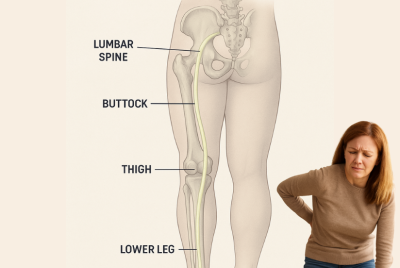How to Avoid Sciatica
Practical Tips and Lifestyle Changes
Learn how to avoid sciatica with practical tips on posture, exercise, stress management, and more for a pain-free, active lifestyle. Sciatica can be a painful and disruptive experience, but thankfully, there are many ways to keep it at bay. In my journey of learning and advising others on spinal health, I’ve seen that small, consistent efforts toward better posture, movement, and lifestyle choices can make a world of difference. So, let’s dive into practical strategies for avoiding sciatica.
Understanding Sciatica and Why Prevention Matters
What is Sciatica?
Sciatica is a condition where the sciatic nerve, which runs from your lower back down through your legs, becomes irritated or compressed. This can cause sharp, radiating pain, numbness, or tingling sensations that can make sitting, standing, or even lying down uncomfortable.
Why Prevent Sciatica?
Preventing sciatica isn’t just about avoiding pain; it’s about maintaining mobility and enjoying your daily activities without restriction. Sciatica pain can disrupt your lifestyle and limit your physical capabilities, so prevention is the best approach.
How to Stop the Key Factors that Cause Sciatica
How to Avoid Sciatica? The main factors that cause sciatica are often the same ones that cause it to come back. These core issues must be addressed to prevent sciatica.
Essential Habits to Prevent Sciatica
Maintain Good Posture
Importance of Ergonomics in Daily Life
Good posture is the foundation of spinal health. Poor posture can place unnecessary stress on your lower back, which over time, increases the risk of sciatica. Ergonomics, or the science of designing spaces that support your body’s natural alignment, plays a vital role here. Whether you’re working, driving, or relaxing, it’s crucial to set up your environment in a way that promotes healthy posture.
Tips for Maintaining Proper Posture
A few quick tips to keep your posture in check include sitting with your back straight, shoulders relaxed, and feet flat on the ground. While standing, distribute your weight evenly on both feet and avoid slouching. Adjust your chair, desk, and computer screen to be at eye level, and make sure your elbows are at a 90-degree angle when typing.
Keep Moving – Exercise to Ward Off Sciatica
Benefits of Regular Physical Activity
Staying active is one of the most effective ways to prevent sciatica. Exercise strengthens your muscles, enhances flexibility, and improves your posture – all of which reduce pressure on the sciatic nerve.
Targeted Exercises for Sciatica Prevention
Strengthening the Core
Your core muscles support your spine and help reduce strain on your lower back. Incorporate exercises like planks, bridges, and abdominal crunches into your routine to keep your core strong and stable.
Stretching Exercises for Flexibility
Stretching helps to relieve tension in the lower back and legs. Focus on stretching your hamstrings, hip flexors, and glutes. Yoga poses like the pigeon pose or the cobra can also be beneficial in reducing tightness around the sciatic nerve.
Protect Your Back at All Times
Lifting Techniques to Avoid Strain
When lifting heavy objects, be mindful of how you move. Bend your knees, keep the object close to your body, and lift with your legs rather than your back. Avoid twisting your spine while lifting, as this can cause strain.
Supportive Footwear for Spine Health
Believe it or not, your choice of footwear can impact your spine. Wearing shoes with adequate arch support helps keep your spine aligned and reduces pressure on the lower back.
Watch Your Weight for Spinal Health
How Extra Weight Increases Sciatica Risk
Carrying excess weight puts additional pressure on your spine and joints, increasing the risk of nerve compression and sciatica. Maintaining a healthy weight is crucial for spinal health.
Tips for Maintaining a Healthy Weight
Opt for a balanced diet rich in whole foods, fiber, lean proteins, and healthy fats. Regular physical activity also plays a significant role in weight management, so aim for at least 30 minutes of moderate exercise most days.
Make Your Workspace Sciatica-Friendly
Set Up an Ergonomic Workstation
If you spend hours at a desk, an ergonomic workstation can help prevent sciatica. Adjust your chair, desk height, and screen position to ensure that you’re not straining your neck or back.
Take Regular Breaks
Sitting for long periods can strain your lower back and sciatic nerve. Stand up, stretch, or walk around every 30 minutes to alleviate pressure and keep your spine flexible.
Manage Stress to Prevent Sciatica
The Link Between Stress and Sciatic Nerve Pain
Stress can increase muscle tension, particularly in the lower back, which may aggravate sciatic nerve pain. Learning to manage stress can help prevent these flare-ups.
Stress-Relief Practices to Adopt
Mindfulness practices such as meditation, deep breathing exercises, and gentle yoga can help reduce stress. Set aside some time each day to unwind and clear your mind.
Choose Supportive Sleep Positions
Best Sleeping Positions for Sciatica Prevention
Your sleep position matters when it comes to spinal alignment. Try sleeping on your back with a pillow under your knees, or on your side with a pillow between your knees to relieve pressure on the lower back.
Selecting the Right Mattress and Pillow
A firm mattress that provides good support can prevent your spine from sagging, which can help avoid sciatica. Look for a mattress that supports your natural spinal alignment.
Seek Early Intervention for Minor Back Pain
Why Early Treatment is Key
Ignoring minor back pain can lead to chronic issues, including sciatica. Addressing discomfort as soon as it arises can help you prevent it from developing into something more serious.
Effective Therapies for Minor Back Pain
Physical therapy, chiropractic adjustments, or even massage therapy can be great ways to alleviate minor back pain before it worsens. Regular visits to a healthcare professional can help keep your back in good condition.
FAQs Related to How to Avoid Sciatica
What is the main cause of sciatica?
The most common cause of sciatica is a herniated disc, which can compress the sciatic nerve and cause pain.
How can I tell if my posture is causing sciatica?
Poor posture can lead to chronic back pain and increased pressure on the sciatic nerve. If you feel strain or tension after prolonged sitting or standing, posture might be a factor.
Can I prevent sciatica if I already have back pain?
Yes! Making lifestyle changes, such as strengthening your core, improving posture, and exercising, can help manage and prevent sciatica even if you have existing back pain.
Does diet play a role in preventing sciatica?
Maintaining a healthy weight through a balanced diet can reduce pressure on the spine and help prevent sciatica.
Are there any home remedies for the early signs of sciatica?
Stretching exercises, warm compresses, and light activity can often help alleviate minor sciatic discomfort before it worsens.
How long does it take to see results from lifestyle changes?
With consistent changes, you can start to see improvements in spinal health and a reduction in sciatica symptoms within a few weeks to a couple of months.
How to Avoid Sciatica – Conclusion
Take Charge of Your Spine Health
Avoiding sciatica involves a commitment to consistent habits that support your spine’s health. From daily posture adjustments to regular exercise, every small step can help you enjoy a pain-free life. Embrace these changes, and give your spine the care it deserves.
Disclaimer
Please note that this article should not replace professional medical advice. Consult a healthcare professional for an accurate diagnosis and tailored treatment plan.






